Over the past years, B2B marketing has emerged as a different discipline in its own right.
There has been a tremendous growth in B2B marketing. Content marketing is driving this growth.
In fact, 69% of the most effective B2B Marketers have a dedicated content marketing group in their organization.
If you’re running a B2B, I want you to know that you need content marketing.
Most of your competitors are already using it.
86% of B2B Marketers are using content marketing. So you have to be smart with the way you approach content marketing.
The B2B e-commerce market will explode in the coming years.
Globally, by 2020 the B2B e-commerce market will be twice as large as the B2C market — $6.7 trillion vs. $3.2 trillion — according to research provider Frost & Sullivan.
You have to ensure your B2B is still alive by 2020.
Content marketing will help you stay on top by then assuming that you also have an excellent product/service.
Therefore, rejoice.
But as I said earlier, you have to do it smart.
So how do you do content marketing for a B2B startup?
One sure way is to hire a link building agency for b2b companies.
Create Long Form Content
We have short form content and long form content.
Short form content are defined as content that can quickly be created.
For example, short articles (under 1,000 words), Vine videos, Snapchat images, tweets, Facebook status updates, short infographics and Instagram photos.
All these are short content.
On the other hand, is long form content.
Long-form content can be defined as in-depth content designed to give its audience a large amount of detail information.
Examples of long-form content are long blog posts, e-books, research, white papers, and a long video.
Short form content may look appealing because it’s easy to create and cheap.
But the problem is that it’s difficult to win customers with short form content.
A short form content might drive a bit of engagement and clicks, but your returns will be short lived.
For example, the average lifespan of a tweet is 18 minutes.

This is increased by the number of followers you have on Twitter.
To be successful on Twitter, you have to be tweeting often.
Maybe, tweeting more than 4 times per hour like Jeff Bullas does:

Publishing long form content will have a big positive impact on your SEO.
Multiple studies found that longer content ranks better in search engines.

An in-depth content allows you to dive deeper into a topic. Something you can’t do with short form content.
Search engines are always looking for better results to show search users. This gives long form content a big advantage.
There’s a little you can say in a short form content. There’s also very little a search user will learn from a short form content.
With long form content, you’re likely to include quotes, examples and facts that back up your points.
For example, Moz created a long form content about how to rank on search engines.
Inside this article, they included a lot of images, screenshots and mentioned some experts too.
Like this:
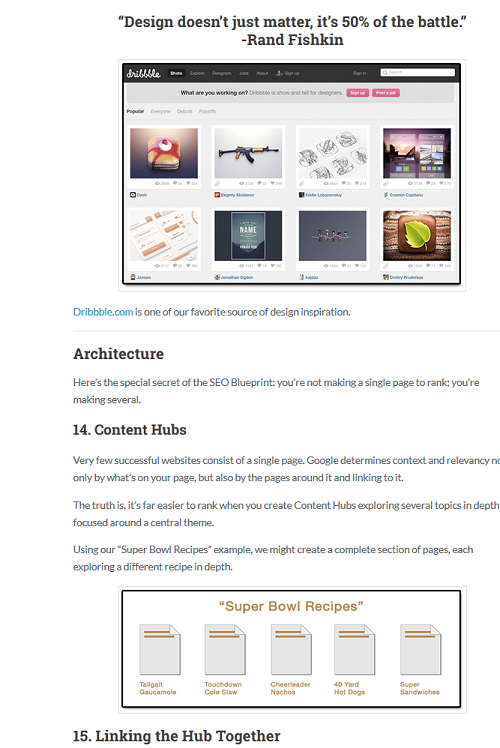
Long form content doesn’t only improve SEO. It also increases the reach of your content on social media.
Buffer did a content audit on their website and found that longer pieces of content have more social shares.

Here’s what they have to say:
“Our posts that exceed 2,500 words receive an average of 6,600 social shares—far and away the most popular post length on the blog.
Our next most popular post length—2,000 to 2,500 words—receive less than half that amount, 3,200 social shares.”
This shows that people love long form content.
With amazing benefits like these, publishing long form content is worth the effort.
A B2B company like HelpScout invests a lot in long form content.
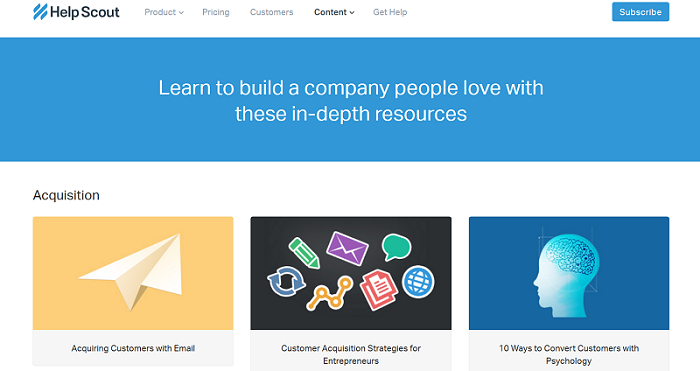
No wonder their site ranks for so many keywords related to their business.
Buffer’s ability to consistently pump out long-form content is the reason why the company is so successful.
Take a look at their increasing visibility on Google according to CognitiveSEO:
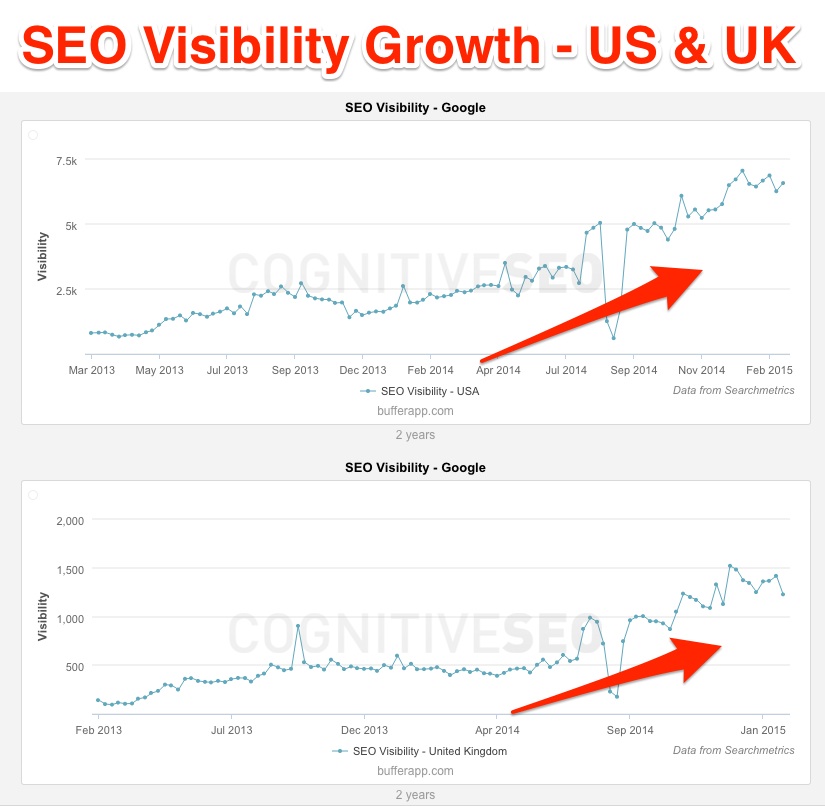
Why publishing in-depth content is such an effective tactic when doing marketing for a B2B?
For instance, imagine this:
Let’s assume that you’re a content consumer. Not a marketer.
You’re about to start a business.
You’re putting your life savings in the new venture.
Every night, you stay awake terrified by the fear that you may not make your mortgage payment.
You’re afraid of not being able to put food on the table.
So you decided to google “how to build a successful business without getting into debt.”
You found an article that tells you everything you need to know.
It tells you the tools you need.
It tells you how to create the perfect business plan.
It tells you what tools and software you need.
It tells you how to get your first few clients. It tells you how to manage your finances.
It’s filled with valuable information.
Then you found a 500-word article that gives you very little information on how to build a successful business.
Which content are you likely to trust?
I’m sure you’ll ignore the second article.
You’re more likely to read the first article more than once.
You’re more likely to share it with your friends on social media.
And because you spent more time on the site, Google will give that site a ranking boost on its search engine.
That’s the power of long-form content.
Long form content will get you everything you want:
- Social shares
- Backlinks
- Show your industry expertise
- More trust from customers
- More sales
And a lot more.
Grasshopper created an 18,000-word guide and spent $1,000 on a sponsored Facebook post.

The result?
They got 949 likes and 180 shares on Facebook.
That was a big investment of course.
But, the investment justifies itself.
You don’t have to write an 18,000-word guide.
You could create guides under 4,000-word.
Have An Editorial Calendar
What’s your content marketing like in the next three to four months?
If you don’t know it, then you’re doing content marketing the wrong way.
A B2B startup should know which direction its content marketing is going in the meantime.
Here’s where an editorial calendar comes in.
According to Wikipedia:
“Editorial calendars are used to define and control the process of creating content, from idea through writing and publication.
An individual or small business might have this publishing process: Brainstorm content ideas to publish, where to publish, and when to publish.”
An editorial calendar allows you, in fact, encourages you to plan your content strategically.
You can tie content offerings to such date sensitive events as holidays, the current season, product launches, company milestones, and trends in your industry.
Your content marketing wouldn’t be based on your feelings of the moment. But rather, on marketing campaigns, trends, buyer personas and keywords.
An editorial calendar also eliminates writer’s block.
Your content will be planned out to one to three months in advance. So you have no excuse.

One of the excuses I often hear is that having an editorial calendar suppress creativity.
No, it doesn’t.
In fact, for me, it helps creativity.
Inside my content calendar, I have those slots for spur-of-the-moment inspiration.
If I get inspired by an idea, I can easily fix that into my content schedule.
An editorial calendar makes me an organized content marketer.
I have my content ideas for guest posts, long form content, e-books, premium content.
I have a separate folder for each inside my editorial calendar.
My editorial calendar makes me a consistent content creator.
If you wake up in the morning and don’t yet know what you’re going to write about, it won’t help productivity. It also won’t help focus.
The quality of your content may also suffer as a result.
The stress that comes with having to think of the headline, outline the content, write the first draft and edit all at the same time, isn’t a good one.
It weighs your mind down.
Keeping an editorial calendar makes content marketing more fun.
Your B2B startup will grow as a result of consistent content creation without affecting the quality.
Create A Blog Connected To Your Website
Blogging is a very important tool in content marketing.
You need it for your B2B startup. No doubt about that.
According to a study, B2B marketers that use blogs receive 67% more leads than those that do not.
67% of more leads could mean a lot to your business.
I’ll assume that you have a brilliant customer-focused B2B startup.
Should you keep your blog separate from your company website?
The answer is NO!
For example, let’s say your company website is www.mycompany.com
Should you integrate your blog with your company website?
Like: www.blog.mycompany.com (subdomain) or www.mycompany.com/blog (subfolder)???
Or, should you keep it completely separate from your blog.
Like: www.mycompanyblog.com???
Keeping your blog attached is highly recommended.
I’m a big fan of the making your blog a subfolder of your website
(Using www.mycompany.com/blog instead of www.blog.mycompany.com).
Here’s why:
A well-written blog is a way to get your company name in front of visitors quickly.
Many web users also expect to see a company blog on your website.
Most B2B companies who blog have their blogs attached to their website.
Having a blog on your company website also creates a smooth experience for the prospect.
Those are just the visitors’ benefits.
Let’s talk about the SEO benefits.
All the backlinks to your homepage and blog pages will boost your overall site’s performance on search engines.
Consistent blogging creates more pages on your website.
More content pages simply mean your website is content-rich and would be viewed as an authority by search engines.
Making your blog part of your main website has some company benefits too.
Having a blog on your sites helps position you as a thought-leader in your industry. Not just a provider of products and services.
It’s also easier and cheaper to establish and promote your brand through your website.
Moz is a perfect example of a B2B company that keeps its blog attached to its main site.
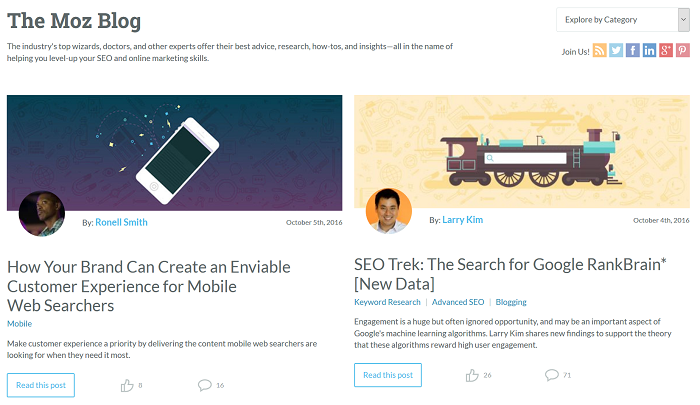
Publish Case Studies
It’s harder to convert prospects in B2B marketing than B2C.
Prospects need real data in order to determine if your product is really for them.
This is where case studies come in.
Instead of blatantly telling people what your product will do, case studies show how real customers are using your product to benefit their lives.
Case studies tell a story. They illustrate how your product can be used.
Without them, you’re stuck with explaining what you do and why it’s beneficial to customers.
Case studies bring your product to life.
Publishing case studies is a great way to take the attention off yourself and focus on the customer.
In fact, prospects will react well to this because they’ll want to get the same results as the case study example.
Case studies also demonstrate success.
Prospective customers care more about what they will get when they start using your product.
Case studies also leverage your customers’ brands.
If you have the big brands as customers, you can put their logo on your website. That increases trust in your brand.
Here’s how marketing firm, Single Grain display the companies they’ve worked with:
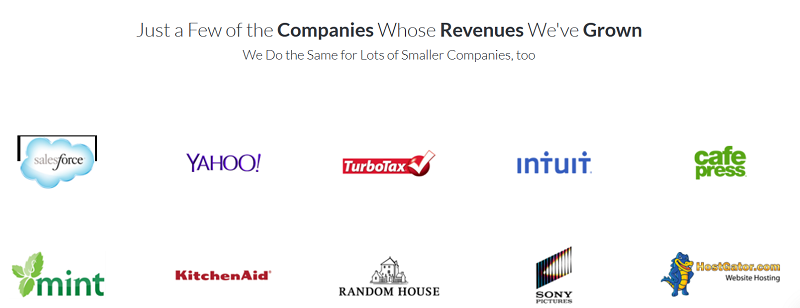
MarketingSherpa published a case study of how they helped a company improves its leads by 52%.
These improvements alone would add about $1,543,320 million in sales pipeline growth to the company.
That increases trust in their services.
Because of a case study like this, you’ll surely want to hire them.
MarketingSherpa has a dedicated category on their website where they publish case studies.
Here’s a screenshot of the page:
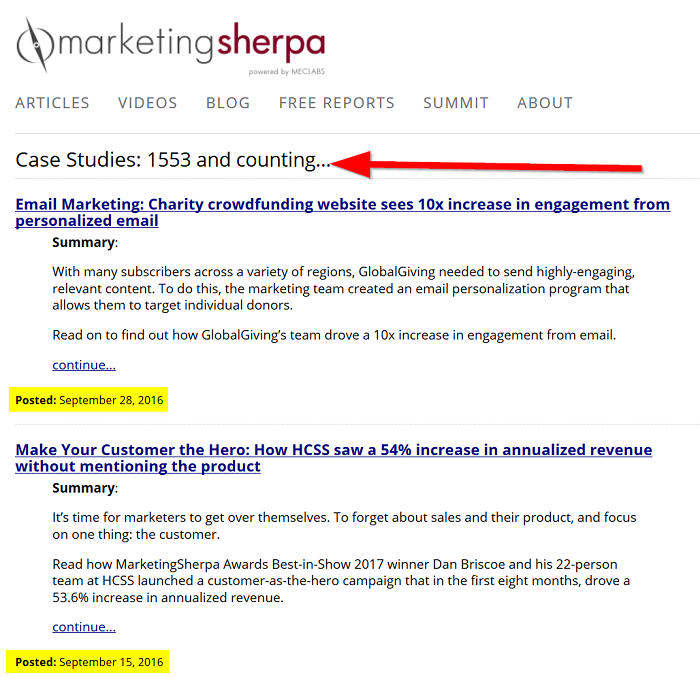
As you can see, they continue to update this page when they have new case studies.
They’ve published over 1,500 case studies so far at the time of writing.
You should do the same thing on your B2B website.
You can put case studies on your homepage.
You can blog about your case studies.
You can create videos from your case studies.
Pioneer Business Systems creates video case studies and post them on their YouTube channel:
Social media is another good place to showcase your case studies to prospects.
Doing content marketing for a B2B startup don’t have to be hard at all.
By following the tips that have been outlined in this article, you’ll become one of the B2B startups to take advantage of the boom happening in the B2B e-commerce world.
By getting your content marketing right, I have no doubt that you’ll build a successful company (assuming the market need your product).
Thanks for reading. And please share this article with your friends on social media.
Related articles: content marketing 2017, things you should know before starting a business blog, make people love through content marketing, skills for creating long-form content
